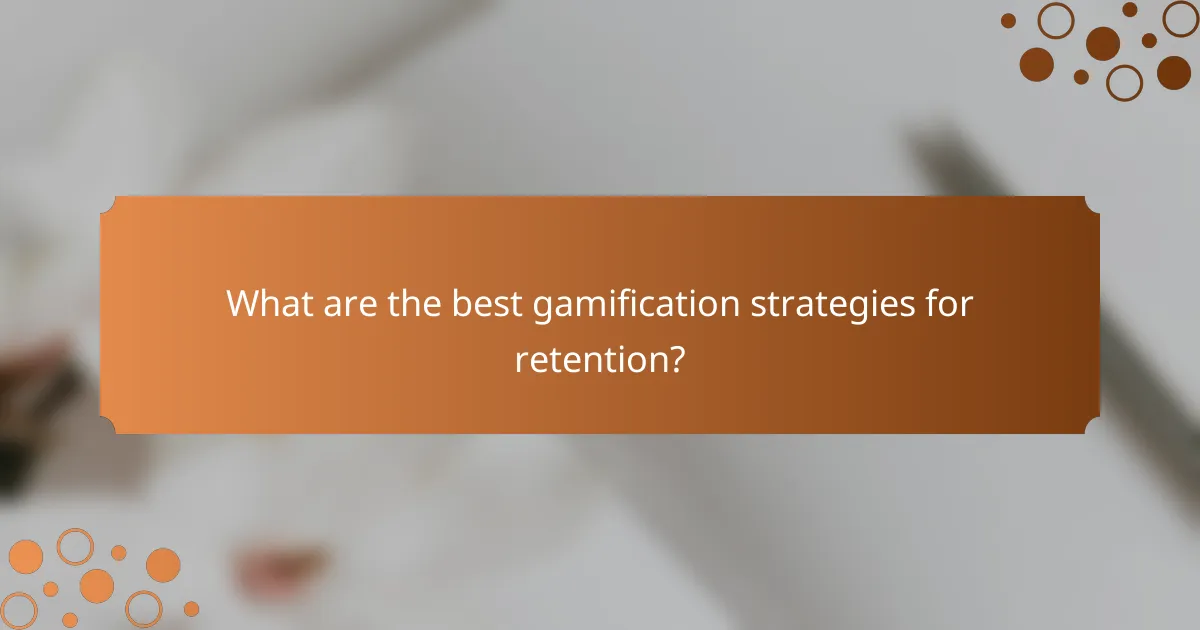Gamification transforms user experiences by integrating game-like elements into various activities, making them more enjoyable and motivating. By utilizing rewards, challenges, and feedback, it fosters deeper engagement and encourages ongoing participation, ultimately enhancing user retention and satisfaction.

How does gamification enhance user engagement?
Gamification enhances user engagement by incorporating game-like elements into non-game contexts, making activities more enjoyable and motivating. This approach leverages rewards, challenges, and feedback to create a more interactive and immersive experience for users.
Increased motivation through rewards
Rewards play a crucial role in gamification by providing users with incentives to participate and complete tasks. These can include points, badges, or tangible rewards that recognize achievements. For instance, a fitness app might offer users points for completing workouts, which can be redeemed for discounts on fitness gear.
To maximize motivation, it’s essential to ensure that rewards are meaningful and aligned with user goals. Consider offering tiered rewards that encourage continued engagement, such as unlocking new features or exclusive content as users progress.
Enhanced interaction via challenges
Challenges foster engagement by encouraging users to test their skills and compete against themselves or others. By incorporating time-limited tasks or skill-based competitions, users are more likely to stay engaged and return to the platform. For example, a language learning app might introduce daily challenges that reward users for completing lessons within a set timeframe.
When designing challenges, balance difficulty to keep users motivated without causing frustration. Providing varying levels of challenges can cater to different skill levels, ensuring that all users find something that suits their abilities.
Improved learning outcomes with feedback
Feedback is a vital component of gamification, as it helps users understand their progress and areas for improvement. Immediate feedback, such as scores or progress bars, allows users to adjust their strategies and stay engaged. For example, an educational platform might provide instant quizzes that show users their scores and correct answers right after completion.
To enhance learning outcomes, consider offering constructive feedback that guides users on how to improve. Regularly updating users on their achievements and providing suggestions for future tasks can help maintain motivation and encourage continuous learning.

What are the best gamification strategies for retention?
The best gamification strategies for retention focus on enhancing user engagement through interactive elements that encourage ongoing participation. Effective methods include point systems, leaderboards, and badges, each designed to motivate users and foster a sense of achievement.
Point systems for tracking progress
Point systems are effective tools for tracking user progress and incentivizing continued engagement. Users earn points for completing tasks, which can be displayed on their profiles, creating a sense of accomplishment and encouraging them to return.
To implement a point system, consider assigning different point values based on task difficulty. For example, a simple task might earn users 10 points, while a more complex task could yield 50 points. This differentiation helps users gauge their progress and motivates them to tackle more challenging activities.
Leaderboards to foster competition
Leaderboards create a competitive environment that can significantly enhance user retention. By displaying user rankings based on points or achievements, leaderboards encourage users to engage more frequently to improve their standings.
When designing a leaderboard, consider offering weekly or monthly resets to keep the competition fresh and engaging. Additionally, providing different categories, such as “Top New Users” or “Most Improved,” can appeal to a broader audience and encourage participation from various user segments.
Badges for achievement recognition
Badges serve as visual representations of user achievements, providing recognition and a sense of accomplishment. Users are motivated to collect badges for completing specific tasks or reaching milestones, which can enhance their overall experience.
To maximize the impact of badges, ensure they are visually appealing and represent meaningful achievements. For instance, a badge for completing a series of tutorials can encourage users to explore more content. Consider offering rare or limited-time badges to create urgency and excitement among users.

Which digital products effectively use gamification?
Several digital products leverage gamification to enhance user engagement and retention. These applications incorporate game-like elements such as rewards, challenges, and progress tracking to motivate users and improve their overall experience.
Duolingo for language learning
Duolingo effectively uses gamification by incorporating levels, points, and rewards to make language learning engaging. Users earn points for completing lessons and can track their progress through a visual interface that motivates continued use.
The app features daily goals and streaks, encouraging users to practice regularly. This consistent interaction helps reinforce learning and retention of new vocabulary and grammar.
Fitbit for fitness tracking
Fitbit employs gamification by allowing users to set fitness goals, earn badges, and compete with friends. Users can track their steps, workouts, and sleep patterns, receiving feedback in real-time to encourage healthier habits.
Challenges such as step competitions or monthly fitness goals create a sense of community and accountability. This social aspect can significantly boost motivation and adherence to fitness routines.
Khan Academy for educational engagement
Khan Academy utilizes gamification to enhance educational engagement through interactive exercises and progress tracking. Users can earn badges and points for completing lessons, which fosters a sense of achievement and encourages further learning.
The platform’s mastery system allows learners to revisit concepts until they achieve proficiency, making the learning process more effective and tailored to individual needs. This approach helps maintain user interest and supports long-term retention of knowledge.

What metrics measure gamification success?
Metrics that measure gamification success include user engagement rates, retention statistics, and customer satisfaction scores. These indicators help assess how effectively gamification strategies enhance user experience and loyalty.
User engagement rates
User engagement rates reflect how actively users participate in gamified elements. This can be measured through metrics like daily active users (DAU), session length, and interaction frequency with game features. A typical engagement rate might range from 20% to 50%, depending on the platform and audience.
To improve engagement, consider incorporating elements like leaderboards, challenges, and rewards that resonate with your target audience. Regularly analyze user behavior to identify which features drive the most interaction.
Retention statistics
Retention statistics indicate how well a gamified experience keeps users returning over time. Commonly measured as the percentage of users who return after a specific period, such as one week or one month, a good retention rate often falls between 30% and 60% for gamified applications.
To enhance retention, implement strategies like personalized rewards, ongoing challenges, and regular updates. Avoid common pitfalls such as overcomplicating game mechanics, which can frustrate users and lead to drop-offs.
Customer satisfaction scores
Customer satisfaction scores gauge how pleased users are with their gamified experience. Surveys and feedback forms can yield scores on a scale from 1 to 10, with higher scores indicating greater satisfaction. Aim for scores above 7 for a positive reception.
To boost satisfaction, focus on creating a seamless user experience and addressing user feedback promptly. Regularly assess and iterate on gamification elements based on user input to ensure they remain engaging and relevant.

What are the challenges of implementing gamification?
Implementing gamification presents several challenges that can hinder its effectiveness. Key issues include the risk of over-gamification, the need to balance enjoyment with practical functionality, and the technical difficulties associated with integrating gamification elements into existing systems.
Over-gamification leading to disengagement
Over-gamification occurs when game-like elements overwhelm users, causing frustration rather than engagement. This can happen if rewards are too frequent or if the mechanics become overly complex, leading users to feel that the experience is more of a chore than a pleasure.
To avoid this pitfall, focus on meaningful rewards that align with user goals. For instance, instead of constant notifications, consider periodic achievements that users can strive for without feeling pressured.
Balancing fun and functionality
Finding the right mix between fun and functionality is crucial for successful gamification. If the game elements detract from the primary purpose of the application, users may lose interest or become confused about how to achieve their objectives.
Ensure that gamification enhances the user experience by integrating elements that support the core functionality. For example, using progress bars can motivate users while still providing clear information about their tasks.
Technical integration issues
Integrating gamification features into existing platforms can pose significant technical challenges. Compatibility with current systems, data tracking, and user interface design must all be considered to create a seamless experience.
To mitigate integration issues, conduct thorough testing and gather user feedback during the development phase. Prioritize scalable solutions that can evolve with user needs and technological advancements, ensuring that gamification remains effective over time.

How can businesses choose the right gamification tools?
Businesses can choose the right gamification tools by assessing their specific goals, understanding their target audience, and evaluating the features of available platforms. The ideal tools should align with user engagement strategies and enhance the overall user experience.
Evaluate user demographics
Understanding user demographics is crucial for selecting effective gamification tools. Factors such as age, gender, location, and interests can significantly influence how users interact with gamified elements. For instance, younger audiences may respond better to mobile-based gamification, while older users might prefer web-based interfaces.
Gathering demographic data can be done through surveys, analytics, or user feedback. This information helps businesses tailor their gamification strategies to meet the preferences and behaviors of their target audience. For example, a fitness app targeting millennials might incorporate social sharing features and competitive challenges to boost engagement.
Additionally, consider cultural differences that may affect user responses to gamification. What works in one region may not resonate in another, so adapting gamification elements to local preferences can enhance effectiveness. Always test and iterate based on user feedback to refine the approach.
